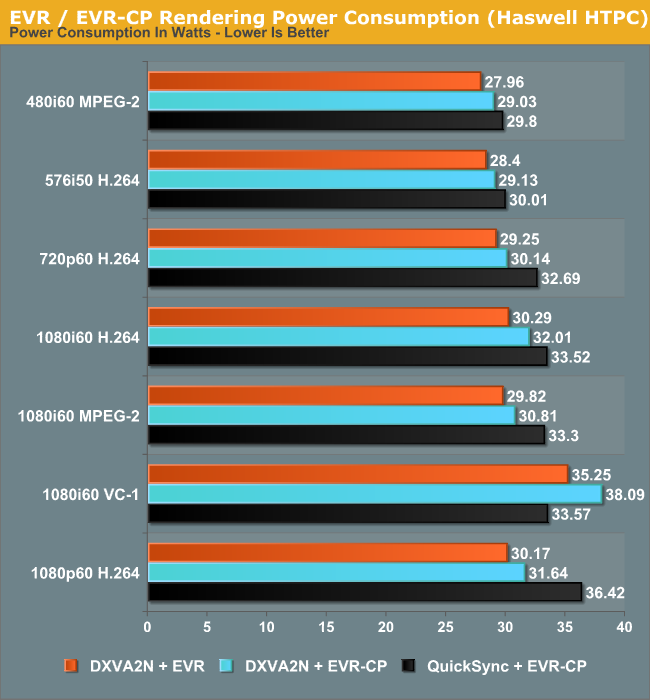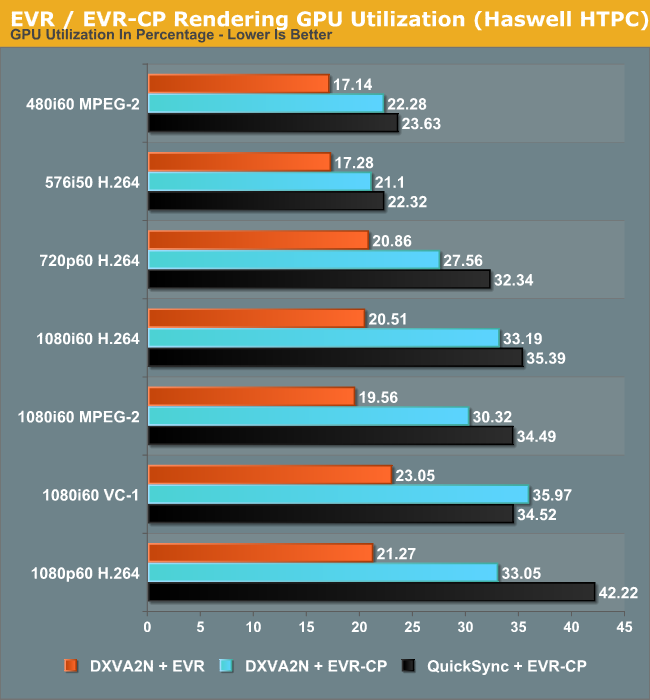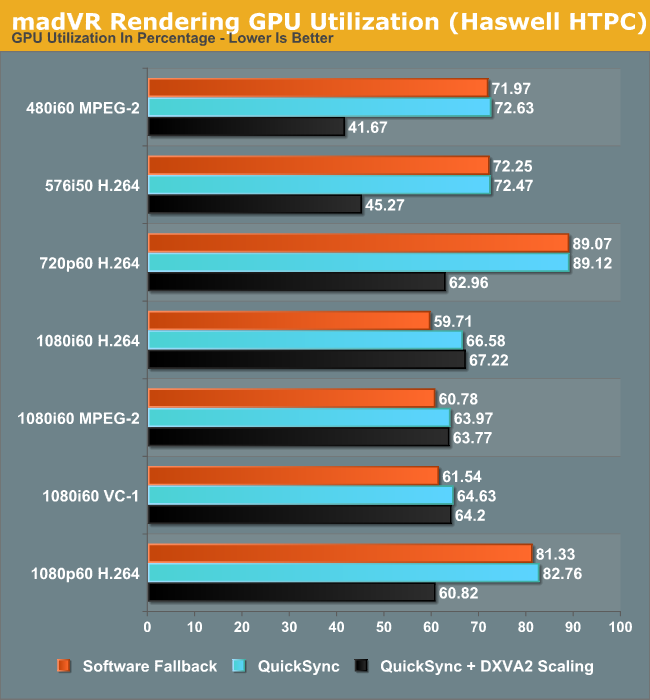Intel's Haswell - An HTPC Perspective: Media Playback, 4K and QuickSync Evaluated
by Ganesh T S on June 2, 2013 8:15 PM ESTDecoding and Rendering Benchmarks
Our decoding and rendering benchmarks consists of standardized test clips (varying codecs, resolutions and frame rates) being played back through MPC-HC. GPU usage is tracked through GPU-Z logs and power consumption at the wall is also reported. The former provides hints on whether frame drops could occur, while the latter is an indicator of the efficiency of the platform for the most common HTPC task - video playback.
Enhanced Video Renderer (EVR) / Enhanced Video Renderer - Custom Presenter (EVR-CP)
The Enhanced Video Renderer is the default renderer made available by Windows 8. It is a lean renderer in terms of usage of system resources since most of the aspects are offloaded to the GPU drivers directly. EVR is mostly used in conjunction with native DXVA2 decoding. The GPU is not taxed much by the EVR despite hardware decoding also taking place. Deinterlacing and other post processing aspects were left at the default settings in the Intel HD Graphics Control Panel (and these are applicable when EVR is chosen as the renderer). EVR-CP is the default renderer used by MPC-HC. It is usually used in conjunction with MPC-HC's video decoders, some of which are DXVA-enabled. However, for our tests, we used the DXVA2 mode provided by the LAV Video Decoder. In addition to DXVA2 Native, we also used the QuickSync decoder developed by Eric Gur (an Intel applications engineer) and made available to the open source community. It makes use of the specialized decoder blocks available as part of the QuickSync engine in the GPU.

Power consumption shows a tremendous decrease across all streams. Admittedly, the passive Ivy Bridge HTPC uses a 55W TDP Core i3-3225, but, as we will see later, the power consumption at full load for the Haswell build is very close to that of the Core i3-3225 build despite the lower TDP of the Core i7-4765T.
In general, using the QuickSync decoder results in a higher power consumption because the decoded frames are copied back to the DRAM before being sent to the renderer. Using native DXVA decoding, the frames are directly passed to the renderer without the copy-back step. The odd-man out in the power numbers is the interlaced VC-1 clip, where QuickSync decoding is more efficient compared to 'native DXVA2'. This is because there is currently no support in the open source native DXVA2 decoders for interlaced VC-1 on Intel GPUs, and hence, it is done in software. On the other hand, the QuickSync decoder is able to handle it with the VC-1 bitstream decoder in the GPU.

The GPU utilization numbers follow a similar track to the power consumption numbers. EVR is very lean on the GPU, as discussed earlier. The utilization numbers provide proof of the same. QuickSync appears to stress the GPU more, possibly because of the copy-back step for the decoded frames.
madVR
Videophiles often prefer madVR as their renderer because of the choice of scaling algorithms available as well as myriad other features. In our recent Ivy Bridge HTPC review, we found that with DDR3-1600 DRAM, it was straightforward to get madVR working with the default scaling algorithms for all materials 1080p60 or lesser. In the meanwhile, Mathias Rauen (developer of madVR) has developed more features. In order to alleviate the ringing artifacts introduced by the Lanczos algorithm, an option to enable an anti-ringing filter was introduced. A more intensive scaling algorithm (Jinc) was also added. Unfortunately, enabling either the anti-ringing filter with Lanczos or choosing any variant of Jinc resulted in a lot of dropped frames. Haswell's HD4600 is simply not powerful enough for these madVR features.
It is not possible to use native DXVA2 decoding with madVR because the decoded frames are not made available to an external renderer directly. (Update: It is possible to use DXVA2 Native with madVR since v0.85. Future HTPC articles will carry updated benchmarks) To work around this issue, LAV Video Decoder offers three options. The first option involves using software decoding. The second option is to use either QuickSync or DXVA2 Copy-Back. In either case, the decoded frames are brought back to the system memory for madVR to take over. One of the interesting features to be integrated into the recent madVR releases is the option to perform DXVA scaling. This is particularly interesting for HTPCs running Intel GPUs because the Intel HD Graphics engine uses dedicated hardware to implement support for the DXVA scaling API calls. AMD and NVIDIA apparently implement those calls using pixel shaders. In order to obtain a frame of reference, we repeated our benchmark process using DXVA2 scaling for both luma and chroma instead of the default settings.

One of the interesting aspects to note here is the fact that the power consumption numbers show a much larger shift towards the lower end when using DXVA2 scaling. This points to more power efficient updates in the GPU video post processing logic.

DXVA scaling results in much lower GPU usage for SD material in particular with a corresponding decrease in average power consumption too. Users with Intel GPUs can continue to enjoy other madVR features while giving up on the choice of a wide variety of scaling algorithms.










95 Comments
View All Comments
Surlias - Friday, December 6, 2013 - link
Hey, I just bought my first 120 Hz capable HDTV, and I'm wondering how to configure it for both gaming and proper 24p media playback. Can I set the a custom resolution of 1920x1080 @ 120 Hz (GTX 770) just like you can with a 120 Hz monitor, and then leave it at that setting all the time? Then games would be able to do VSync up to 120 fps, and media would be able to lock in at 24p because it's an even divisor of 120. Or is this not possible on a TV due to HDMI limitations? If this is the case, then will it be necessary to manually switch back and forth between 60Hz and a 24 Hz custom resolution depending on the usage situation (since 24 Hz would be awful for gaming)? I've always found this particular subject confusing and I'm hoping someone can help me understand how this works. FYI, I mostly use XBMC for media playback, which has an option to "sync to display refresh rate", which I assume would be essential for enabling 24p playback.redmist77 - Tuesday, April 8, 2014 - link
I'm amazed at how well Haswell locks the video and audio sync. I can output 23.976Hz video to my plasma TV and all of the AV sync graphs in MediaPortal or MPC-HC are *dead* flat and there's never a stutter. 24Hz, 50Hz and 59.94Hz are all perfect too. That's possibly the holy grail of a HTPC. I haven't found any other bugs (DXVA2 etc.) either so it's looking good. DTS-HD, Dolby True HD bit streaming also works perfectly. 0-255 RGB HDMI output requires a registry fix but that's no big deal (default is 16-235)The next great challenge is a gaming HTPC that uses Intel 4600 for video and a giant PCI-E card when launching a game ;) I've sort of got it working using DisplaySwitch.exe and two HDMI inputs on my AV receiver but it's not quite seamless.
khmara - Friday, May 30, 2014 - link
The flickering that is seen during the test with the Haswell in 4k on the Seiki 4k TV was due to Intel graphics settings having the refresh rate default at 29. If you manually change it to 30 the flickering is eliminated.Tassadar - Thursday, June 12, 2014 - link
Hi all,I have a HTPC with an intel haswell and I can't get 23,97 fps, I have 24 even if i set 23 in intel panel properties.
I have run CustomModeApp.exe but I only can enter entire numbers (no decimals) in the frequency. I also have try 23 but doesn't allow me to accept.
Any help?
Thanks
Gadgety - Monday, August 18, 2014 - link
"... but the HDMI link never got locked (the display would keep flickering on and off). The frequency of locking was inversely proportional to the HDMI cable length... We will update this section as and when we reach closure on the issue with ASRock / Intel."This was in June 2013. Still no closure after 13 months?